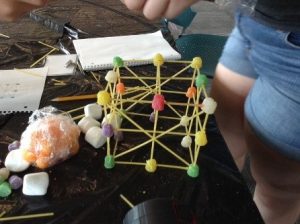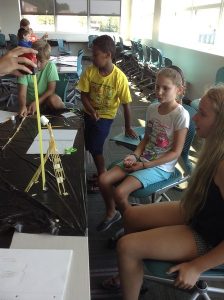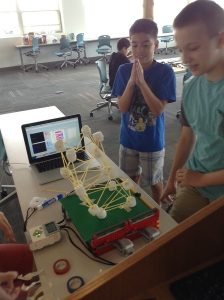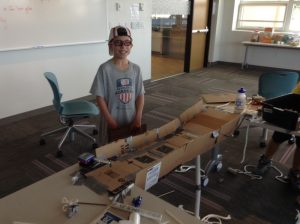by Annie Levine
How can you tell if a structure has been damaged by strong winds, heavy loads, an unexpected storm, or even an earthquake? Sometimes you can see the damage visually, but more often than not, the damage goes far beyond what the eye can see. A growing field in Civil Engineering is Structural Health Monitoring; the study of analyzing data (from sensors) in order to detect damage in a structure. SHM is paramount to today’s infrastructure largely due to the fact that the buildings, bridges, and roadways are aging and not able to handle the increasing natural disasters plaguing the world. Being able to detect, and ultimately repair, unseen damage in infrastructure can save many lives.
In 2012, Professor Babak Moaveni in the Department of Civil & Environmental Engineering was awarded a prestigious NSF CAREER research grant to study structural health monitoring and to developed K-12 outreach on the topic. Professor Moaveni partnered with the CEEO to create a week-long summer workshop that introduces middle school students to ideas in civil engineering and structural health as well as pqiues students interest in engineering careers. Development of the project began with activity creation in the Summer of 2014 and this past summer the first version of the camp was piloted during 2 different week-long session with 16 students in each one.
Day 1 of the workshop introduced the students to sensors, the basics of buildings, and static loading. We utilized EV3 light sensors and the Mindstorms Data Logging software to teach the students how to read/interpret graphical data. One of the activities was a mystery where the students had to figure out the path a “burglar” took through the room based on the graphical data they collected when the instructor shined a flashlight at the sensors, which were set up around a dark room. Activities like this, where sensor data is displayed and the student have to figure out what happened, were very popular and useful in teaching about sensors and data analysis.
To introduce the students to building, we used spaghetti, marshmallows, and gumdrops to have the students build structures that could hold weight. This was to get them thinking about what goes into building towers: wide bases, how to increase strength, importance of triangles, etc.
The topics for the second day shifted to introducing the students to dynamic loading and the concept of frequency and how it relates to damage. The students were given the same materials (spaghetti, marshmallow, gumdrops) to build tall structures that could withstand lateral movement in an earthquake simulator. We borrows a NEES shake table from Purdue University; however, we also made one using Legos and EV3 motors which worked just as well (Instructions found on Legoengineering website, can by hyperlinked, if appropriate http://www.legoengineering.com/shake-table/). The activity for introducing frequency was having the students jump for 10 seconds to find out how many they could do in the given time frame. The concept was then brought back to how a building moving at an unnatural frequency can create damage.
The third day’s activities shifted from building towers to building bridges, in an activity that brought in money/budgeting and a wide range of materials for use. We set up a “store” with items such as: Popsicle sticks, paper towel tubes, string, wood, Play Doh, pipe cleaners, really anything found in a craft closet, with varying prices and the students were given a set amount of money to spend on materials to build a bridge.
The penultimate day was spent introducing the students to the concept of acceleration and interpreting acceleration data using Hi-Technic accelerometers. This included a field trip to a local bridge on the Tufts campus that has actual accelerometers, thermocouples, and strain gages for data collection, which collected data as the students ran across. We returned to the classroom and analyzed the acceleration graphs to correlate what the graphs showed to the running/jumping that the students did on the bridge, and how that might change if the bridge was actually damaged.
The last day was a culmination of all the concepts that were taught during the week in a final project that the students had all day to complete. The challenge was for them to build a four foot bridge that had specific width requirement that had to hold weights, and they had access to all sorts of materials. Additionally, they had to include sensors to warn when the bridge is under too much stress. The students seemed to really enjoy the challenge and understand how the sensors are used to detect damage in a building.
The activities and workshop structure will be revised and retested during the Summer of 2016. The final package of activities will be disseminated on LEGOengineering.com and STOMPnetwork.org





This workshop purpose is great. Yes, it’s true most often it becomes tough to consider whether a natural disaster how much is gonna damage a particular structure. Therefore, this workshop presented each presentation will be highly effective to measure such causes.